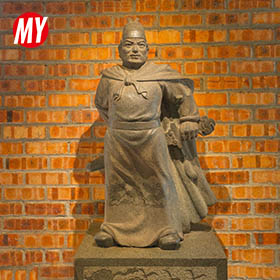Mount Taishan
The Spirit of Qi Lu
Located in Tai'an, Shandong Province, China, Mount Taishan of The East has been considered to be the head of the Five Great Mountains since ancient times. It has become a tradition for emperors to come to Mount Taishan to offer sacrifices and prayers to heaven. Cliff rock carvings, Taoist temples and other ancient monuments can be seen everywhere in the scenic area, and Mount Taishan is a famous national geological park, too.
Mount Taishan (泰山) is located in Tai’an City, Shandong Province, China, with its main peak 1545 meters above sea level, also known as Dongyue (东岳), the Great East Mountain. Due to the extremely special political role that Mount Taishan plays in Chinese culture, it has been considered since ancient times to be The Head of the Five Great Mountains.
Emperors in Chinese history called themselves the Son of Heaven, and Mount Taishan was considered to be the closest place to heaven. So starting with Emperor Qinshihuang, many emperors have come here to perform the great ceremony of worshipping the heaven and earth. It is also the place where the Taoists, Confucians and Buddhists of different faiths built their religious buildings, and the three religions of Confucianism, Buddhism, and Taoism were united here, which is another characteristic of Taishan culture.

One or two thousand years ago, it was not an easy task to climb Mount Taishan. The trails and related facilities have been perfected through time, and the mystery of the mountain has been revealed to the world. If you take a tour bus or cable car, you can get there in only an hour or two to get to The Summit of Mount Taishan, not to mention Mountain Pickers who spend years and years climbing up for goods delivery.

The Daizong Archway (岱宗坊) located on the north side of the Dai Temple is the starting point for ascending Mount Tai, but the real climbing process begins with the steps starting from First Heavenly Gate (Yitianmen 一天门), one kilometer north.
The ascent of Mount Taishan can be divided into two stages, the first of which begins at the foot of the mountain at First Heavenly Gate and ends at Middle Heavenly Gate (Zhongtianmen 中天门), which is 847 meters above sea level. This stage of the trail is not difficult, with a total of 2,400 stone steps. From Zhongtianmen, the road is flat and passes by Yunbu Bridge, which is so pleasant to walk on that it was given the name “Three Miles of Joy”. Unfortunately, the good times were short, and the next Eighteen Bends (十八盘) were the biggest challenge for climbers before the summit of Mount Taishan. The second stage requires climbing 1,600 stone steps, and the Eighteen Bends are very steep, especially in the last part, where The Stone Steps Reaching to the Sky, and the South Heavenly Gate (Nantianmen 南天门) at the end of the road become faintly visible, as if climbing to the sky. It’s a pity that many people don’t make it this far. When you arriving South Heavenly Gate, the climbing phase is over, and the only thing that awaits you is the view from the top of the mountain and the joy of success.

The top of Mt. Taishan has a wide 600-meter-long avenue called Tianjie (天街), The Sky Street. It’s a great place to visit, if you can ignore the Bottomless Cliffs, Tianjie is just like a normal shopping street. At the top of the mountain, there are religious buildings such as the Bixia Yuanjun Shrine, Jade Emperor’s Peak and Qing Di Gong. Bixia Yuanjun Shrine is dedicated to the sacred mother of Mount Taishan, Bixia Yuanjun, who is also known as the Grandma Taishan; Jade Emperor's Peak is built on the highest point of the main peak of Mount Taishan, the extreme top stone in the courtyard is 1545 meters above sea level. It is said that Confucius once climbed to the top of Mount Tai and looked out on Qufu, the hometown of the Kingdom of Lu, which is today’s Zhanlu Tai (瞻鲁台).
Attractions around Mount Taishan
Tags:
Related
Fujisan Hongu Sengen Taisha Shrine360
Head of 1,300 Sengen ShrinesDanube - Vienna360
River of A Familiar MelodyThe Ancient City Tower OF Pingyao360
Ancient Town LandmarkJiufen Old Street360
The Fairy-Tale Town of GoldmineYokohama Minato Mirai 21360
The Future City by Tokyo BayTomb Of Napoleon / Dome des Invalides360
Founder of An EmpireSanta Maria della Vittoria360
The Ecstasy of Saint Teresa by BerniniMeguro River360
Iconic Night Cherry BlossomsNational Museum Of Malaysia360
A Snapshot of the Long HistorySaturday Night Market Walking Street360
Enjoy Yourself Every WeekendParc du Cinquantenaire360
Fiftieth Anniversary of IndependenceThe Palace Museum - Six Palaces of East Road360
Residences for Concubines





















No comments yet, post the first one!